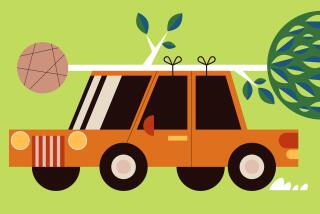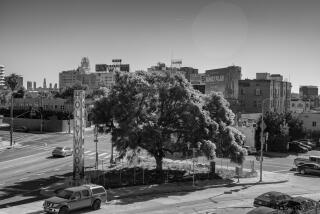Why Trees Fall
- Share via
The sound of chain saws greeted the first week of the new year in most Southland communities as powerful Santa Ana winds toppled thousands of trees from the San Fernando Valley to Orange County.
The Arboretum of Los Angeles County in Arcadia lost more than 100 trees, and 60 toppled at the Huntington Botanical Garden in San Marino, where powerful gusts snapped trees in half. The Jet Propulsion Laboratory, close to hard-hit Altadena, clocked gusts at more than 120 mph.
Some trees blew down simply because the winds were so ferocious, but others were already in trouble well before the winds began to howl.
Many “were waiting to come down, even on a calm day,” said arborist Bob Hansen, who has been working with trees for 40 years on Los Angeles’ Westside and in the Valley.
Other arborists agree and point to problems that began when the trees were planted.
Hansen, a consulting arborist, said that such damage usually has to do with the roots, or lack thereof, and that such problems often can be traced to the trees being root-bound in nursery containers.
Patrick McCullough of La Crescenta, a certified arborist who has been working with trees for 20 years, is convinced that the No. 1 reason for trees toppling or doing poorly is girdling roots that begin circling around inside the nursery can at a young age and then forever restrict the tree’s growth and health.
He considers this a tree’s Achilles’ heel and a widespread problem. “Virtually every tree planted from a medium or large container has girdling roots,” he said.
The type of tree you plant is of little importance as a predictor of a long and healthy life, arborists agree. The key is how the tree is planted.
“The kind of tree is way secondary,” McCullough said. Irvine arborist Stephen Holcomb goes further: “It has nothing to do with the species of tree. Nothing, zero.”
Arborists point to other problems--changes in the tree’s physical environment or poor planting practices--as other reasons why trees fail.
*
Poorly developed root systems also bring on such problems as disease that may cause the trees to weaken and fall, McCullough said.
Root problems can’t be fixed on existing trees, but they are easy to prevent: Simply plant very young trees that have not become pot-bound.
He suggests buying trees in one-gallon nursery cans and checking even these saplings to make sure there are no circling roots. Trees are first planted in what nursery people call “liners,” and if they are not moved quickly into gallon cans, the roots may begin their circling at a tender age. Later root growth hides this early defect.
Julian Herman, who has been working with trees for about 60 years as a landscape architect and nurseryman, thinks the root problem began in the last 20 or so years.
When he opened his first nursery in North Hollywood in 1945, most homeowners did their own research and then bought and planted their own trees.
With young families to raise, they bought small, inexpensive saplings that grew to become strong, stately trees. In more recent years, homeowners have become more affluent and less patient. They want trees to be tree-sized instantly, so they buy them too large.
“They want the biggest, but they would be better off with the smaller,” he said.
Irvine arborist Holcomb pointed out that a five-gallon tree will outgrow a 24-inch-box tree in less than five years, so’s there’s little point buying the bigger tree. Only a little patience is required.
Herman, who ran the Irvine Wholesale Tree Nursery and started Pacific Arbor Nurseries for Pacific Sod, had another tip: Never buy a tree whose leafy branches spread beyond the edge of the container. This is especially important if you buy a tree in a larger container.
Tree-planters should also do their homework, looking up trees in a good reference, such as the Sunset Western Garden Book, to make sure they know what its requirements are and how big it will get. Putting a tree in the right place, and giving it enough room, are equally important.
For those who have the budget and are determined to plant a large tree, McCullough suggests what is called a “field-grown specimen.” These are trees that are grown in the ground and then dug up, boxed and moved to a garden, so the roots have not been constricted in a container.
There are several nurseries that specialize in these, including Baron Bros. and Pacific Arbor in Camarillo and Sunny Slope Trees in Orange, but they deal primarily with landscape designers and contractors, because a field-grown tree can cost more than $1,000.
Most homeowners will be better off starting with small trees and planting them properly.
After making sure that the roots are not circling, or after untangling or pruning any that are, dig a squarish hole that is not quite as deep as the root ball is tall. After planting, the top of root ball should actually be above the soil an inch or so. Trees, and most other plants, should never end up with their bases buried below the soil level.
Never do anything to the soil directly under the root ball. Disturbing this soil will cause it to settle later on, and the tree may end up too low.
Herman believes that square planting holes help prevent roots from going in circles, because they quickly run into a corner and aren’t good at right-angle turns.
When filling the hole in, add soil amendment only to the top 6 inches of soil, but do so in as large an area as you can, at least in a 4- to 6-foot circle around the tree.
Herman cautions not to plant sod up against the base of the tree but to leave a good 5 or 6 feet of bare ground around the base of the tree so the soil and tree roots can breathe.
McCullough cautions that container-grown trees are accustomed to getting a lot of water, so they should be watered several times a week at first. As the tree becomes established, it should get water less and less often.
Holcomb, who as a certified arborist has been working with trees for the last 30 or so years, suggests another reason for trees falling during windstorms.
“I’ve looked at hundreds, and over 80% of them have had some kind of construction going on around them in the last five years,” he said.
Especially with older trees, Holcomb said, the cause of toppling is almost always some recent modification of its environment. Perhaps a new lawn has been put in around it so the tree is getting too much water. It might be new paving or other new construction nearby, or trenching for pipes.
“If trees are planted in the right place, and in the proper way, and the environment around them remains stable, they’ll be there a very long time,” he said.
He points out that very few trees fall over in rural areas where they remain undisturbed, but that in the constantly changing city, they are more vulnerable.
(BEGIN TEXT OF INFOBOX / INFOGRAPHIC)
Why Trees Fall
Planting a Tree
Most trees’ roots inhabit only the top 3 feet of soil. Proper planting techniques can help them get a good grip.
1. Prepare a hole with sides tapering outward at bottom with a platform of undisturbed soil in the center.
2. Set the plant in the center. Gently loosen tangled roots; spread them away from trunk. The top of the rootball should be 1 to 2 inches above the ground level. Fill the hole with soil.
3. Place a pair of 2-by-2-inch stakes about 1 foot away from the trunk on either side of the tree. Tie the tree to the supports with flexible garden tape.
4. Mound the soil surrounding the tree to create a watering basin. The base of the trunk should remain dry.
-Two stakes should be driven deep enough and extend high enough to brace tree for several years.
-Top of rootball should be slightly higher than surrounding soil.
-Watering basin.
-Do not amend soil deeper than 6 inches.
-When buying, look for tree with modest foliage.
-Keep grass 4 to 6 feet away from tree.
-Untangle rootball, removing broken, dead or diseased roots.
-Do not dig or disturb soil under rootball.
Source: Robert Smaus, arborists
Root Girdling
Avoid choosing a tree whose branches have spread beyond the edges of the spot. This may indicate circling or girdling roots, a condition which, if left uncorrected, may result in a tree prone to toppling and other problems.
(BEGIN TEXT OF INFOBOX / INFOGRAPHIC)
Trusty Trees
For those looking to replace a tree that toppled in January’s windstorms, here are a few trusty trees suggested by arborists. They stress that the way a tree is planted and cared for is more important than the kind of tree.
Arbutus ‘Marina’
‘Bradford’ ornamental pear
Canary Island pine (larger properties)
Carrotwood
Chinese flame tree (Koelreuteria bipinnata)
Chinese pistache
Cork oak
Ginkgo
Goldenrain tree (Koelreuteria paniculata)
Jacaranda
Liquidambar (larger properties)
Magnolia grandiflora
Mayten tree
New Zealand Christmas tree (Metrosideros excelsus)
Podocarpus gracilior






